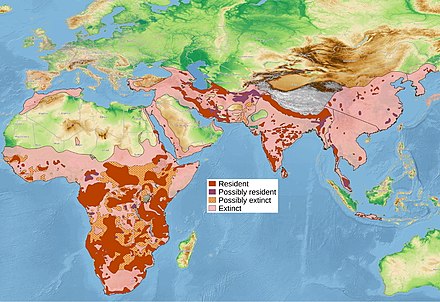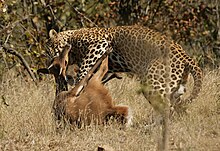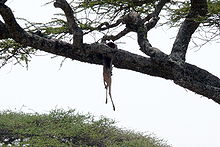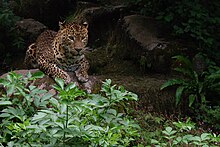leopard
| leopard | ||||||||||||
|---|---|---|---|---|---|---|---|---|---|---|---|---|
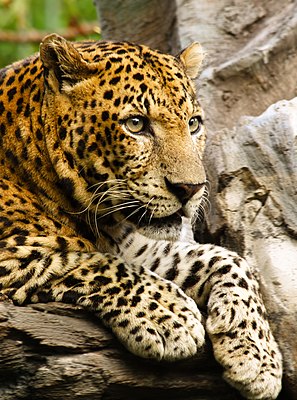
Leopard ( panthera pardus ) |
||||||||||||
| Systematics | ||||||||||||
|
||||||||||||
| Scientific name | ||||||||||||
| Panthera pardus | ||||||||||||
| ( Linnaeus , 1758) |
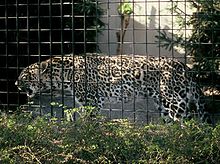
The leopard ( Panthera pardus ) is a species from the cat family that is found in Africa and Asia . It is also found in the Caucasus . The leopard is the fourth largest big cat after the tiger , lion and jaguar . On the endangered Red List species the IUCN are leopards in the early warning as "Vulnerable" (endangered) classified. The word leopard comes from the Latin leopardus from the ancient Greek λεόπαρδος (leopardos) , which is composed of λέων (leon) for lion and πάρδος (pardos) for panther .
features

Dimensions and weight of the leopard vary widely within the large distribution area. In general, forest-dwelling leopards are usually smaller and stockier, those of the open habitats are usually slimmer and larger. The leopard is 90–190 cm long, not counting the 60–110 cm long tail. Male leopards weigh around 40–90 kg and have a shoulder height of 70–80 cm. Females are around half the size and weigh only around 30–60 kg. Small females measure only 18 inches at the shoulder. In the Cape region in South Africa , leopards often weigh only 20–30 kg.
Fur drawing
The coat pattern is often very different depending on the subspecies, but individual differences also occur within one area. The fur almost always shows rosettes , which are arranged in rows, especially in the longitudinal direction of the back. On the chest and lower neck, instead of rosettes standing side by side, strawberry spots are often found, which are arranged in one direction and act like collars. At the top of the long tail, the rosettes continue along the center line. Towards the end of the tail, the rosettes become less and less pronounced, but can sometimes still merge into several transverse rings. The underside of the tail is very light to white towards the end. The belly and the upper inside of the legs are also free of rosettes and colored white, yellowish-white or transitioning to gray. Farther towards the paws, there are full stains that get smaller and smaller towards the bottom. There are also only black full spots on the head and upper neck and neck. Forest leopards are generally more intensely colored than leopards in open landscapes.
Black panthers
At high altitudes and in the tropical rainforest you can sometimes find black cats , also known as black panthers . The expression of the black coat is hereditary and is inherited recessively via a single gene (monogenetic) . This means that the genetic make-up can also be present in a normally spotted leopard or there can be black flukes in a litter next to normally colored young animals. However, when the light falls at an angle, the typical rosettes can also be seen in black leopards. In some areas, such as the Malay Peninsula , up to 50 percent of all leopards are black. In Africa, blackens were most common in the Ethiopian highlands . In 2019, recordings of black leopards in Africa were released which the media falsely claimed was the first such sighting in Africa since 1909.
Sense organs
The ears are rounded. The sense of hearing is well developed. Leopards can perceive very high frequencies of up to 45,000 Hertz that humans can no longer hear . The eyes are directed forward and have a wide overlap of the fields of view. This enables them to have excellent spatial vision. During the day, the eyesight of a leopard is roughly the same as that of a human, but at night the leopard has five to six times better eyesight: Leopards can open the round pupil very wide so that more light can enter the eye; furthermore, like all cats, leopards have a reflective layer behind the retina , the so-called tapetum lucidum , which increases the light yield by reflecting backwards. The sense of smell is also excellent.
Distribution area, habitat and stock conditions
Historically, the leopard was widespread across Africa on both sides of the Sahara and across large parts of Asia . In Africa he lives in the central rainforests as well as in the mountains, savannas and semi-deserts from Morocco to the Cape of Good Hope . The leopard only avoids the large, waterless deserts and is therefore naturally absent in the Sahara and the driest regions of the Namib . In Asia he lives in the coniferous forests on the Amur as well as in the tropics of India and Southeast Asia . Here it penetrates in the southwest to the Arabian Peninsula , to Israel and Anatolia and in the southeast to the island of Java . However, it is missing on Sumatra and Borneo , as well as in the waterless core deserts of Asia, such as the Rub al-Chali . However, fossil finds show that the leopard once inhabited Sumatra as well. The northern border of the Asian distribution area runs today from the Caucasus via northern Persia , Afghanistan and Kashmir , along the Himalayas to the Amur River in eastern Siberia. In prehistoric times there were leopards in Central Europe. But here they disappeared at the end of the Ice Age . The leopard has the largest range of all seven big cats .
In many areas, however, leopards are now extinct . These include Morocco , the Sinai Peninsula and the island of Zanzibar . In other regions, such as the Caucasus and the Amur region, extinction can hardly be prevented. On the Arabian Peninsula there are fewer than 250 free-living, fully grown individuals in fragmented populations, of which 50–100 are in Oman (2013). The numbers in Anatolia and Palestine are even lower . In the Caucasus survival as assessed by the WWF just under 50 individuals whose protection is currently the object of large efforts.
In Iran and Turkmenistan only a few hundred specimens of the Persian leopard live, in Pakistan and Bangladesh leopards are also very rare today. In China, leopards are almost only found in isolated remnants. In contrast, it is estimated that around 14,000 leopards still live in India.
Most leopards now live in Africa, south of the Sahara. Here the number of leopards is estimated at up to 700,000 (as of 1988).
behavior
nutrition
What leopards eat depends primarily on the food available in the respective habitat. Leopards have an extraordinarily wide range of prey, ranging from beetles to reptiles to birds and large mammals. If at all possible, however, leopards try to prey on mammals weighing between 30 and 50 kilograms. Mostly these are medium-sized ungulates. Depending on the region are its main prey deer as axis deer and sika deer or antelope as SASINS , Bushbuck or Impala . A relatively large part of its diet is made up of smaller predators such as mongooses and jackals . But he also dares to attack such well-fortified animals as wild boars , bush pigs , porcupines and baboons , which he usually attacks under cover of night. Zebras are already too big to prey on, but occasionally they tear a careless foal from these equines .
Hunting way
Most leopards are viewed as nocturnal hunters, but no general preference for certain hunting times has been found so far. The timing of a hunt is probably related to the availability of the prey in its hunting area.
Basically, one can observe two principally different ways of hunting with leopards: the sneaking hunt and the more passive stalking hunt . Sneak hunts are one of the most common hunting methods used by the leopard. Leopards are quick to set off and cover several meters in just a few leaps, but even at medium distances, most prey animals are faster than them. The cat therefore tries to get as close as possible to its victim unnoticed in order to shorten the distance before the attack. When sneaking up, leopards often perform enormously. In the Kalahari and other barren desert regions, they have to sneak up on their victims over enormous distances with almost no cover. Pure ambush hunting, in which the hunter waits for his victim, is also a hunting method that can often be observed with leopards. Leopards that spend the day in trees often use them as a raised hide. With remarkable patience, they allow appropriately sized herds of grazing animals to pass or graze by themselves or occasionally directly under their lookout. If the branch the leopard is resting on is not too high, it can jump straight onto its prey from above. Most of the time, however, it leaves the tree before the actual attack. To do this, he carefully climbs down the side of the tree trunk that is not visible to the chosen victim and looks for cover behind the trunk or - if available - behind other dense vegetation. After a very long waiting time on a branch of the tree, they can spend the same time at the foot of the tree again to wait for those animals that they have observed from above over a long period of time approaching the tree in question. There are no observations or reports as to whether leopards choose their prey at the beginning of the sneak or hide hunt , or whether they leave it to chance which animal in a group they want to kill.
Occasionally, the robber just looks for his prey while roaming around the area and surprises them. Fawns lying apart from hornbeams or rabbits huddling motionless against the ground are often discovered purely by chance in passing, and not sneaked on deliberately.
Leopards are also content with carrion or drive weaker predators, such as cheetahs , from their rift.
Loot protection
Sometimes the leopard's prey is stolen by lions , spotted hyenas or saddleback hyenas , which are usually noticed by vultures . Therefore, it usually tries to drag its prey into a protective thicket or to bring it up a tree.
He eats the crack from the underside until finally only the head, neck and back are left.
After the meal he covers his prey remains, if they are on the ground, with grass, twigs or leaves by scratching this covering material over it with all four legs.
Locomotion
The normal mode of movement is the step in the typical cloister . In this gait, the legs that are diagonally opposite each other are lifted and put back down at the same time. In this mode of locomotion, leopards can travel long distances.
The trot with which leopards cover short distances is faster. When sneaking, it can happen that the first 10 to 30 meters are covered at a trot, with the body crouching more and more. This is also referred to as crawling. On the hunt, this creeping is then replaced by creeping, in which the stomach almost touches the ground and a very slow step is observed, which can be interrupted at any stage. This usually happens when the sneaked prey becomes aware. The leopard remains in this position until the victim becomes less vigilant and can continue to sneak.
In a sprint, a leopard can reach more than 60 km / h. This can be seen especially in the final phase of a hunt; so he uses the expansive jumps for the last few meters after sneaking up or from the hide, where he usually starts with both hind legs at the same time. At such a high speed, however, leopards can only travel short distances.
A special form of locomotion is climbing trees and climbing around on branches of various thicknesses within the treetop. When climbing the tree, the claws, which are normally retracted, are extended and fix the heavy leopard body itself to a smooth, vertical, thick trunk by penetrating deep into the bark. A steep tree is conquered in jumps. The front legs are spread wide and can embrace thick trunks. The leopard often makes a particularly large jump up from the ground, which already provides the momentum for the further jumps.
When descending from a tree, the leopard walks forward as long as the branches or trunks are not completely vertical. In the case of really steep trees that do not give any support, the descent is backwards until a distance from the ground is reached that the leopard can jump over. To do this, he turns around on the tree trunk, possibly descends one to two meters and then jumps down from a height of two to four meters.
Leopards are good swimmers too. Leopards have been observed spending the day on an island in a river and swimming back to shore to hunt.
Territorial behavior
Leopards are typical loners. The roaming areas of neighboring female leopards sometimes overlap considerably. The much larger ranges of male leopards can overlap with those of several females. According to a study in the Kruger National Park , males claim around 16–96 square kilometers and females 5–30 square kilometers, depending on the density of prey. In very barren, loot-poor regions, the home areas can be a lot larger. The territory is marked and defended against same-sex conspecifics under threat behavior and, if necessary, in territorial combat behavior. A territory owner can secure the privilege of access to sexual partners, but also to sources of food, water points, shady areas and cover options.
First and foremost, leopards mark their territory with urine and excrement, but also acoustically with their characteristic sawing - a sound that is reminiscent of wood saws. In addition, they visually mark the boundaries of the territory by scratching the trees or the ground. On the one hand, the marking has the function of keeping conspecifics away and informing other animals about the presence of the territory owner, but on the other hand it also serves to structure the home area. Odor marking makes it easier to find your way there.
Reproduction
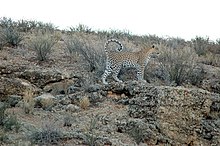
For a few days, a female will tolerate a male leopard in its environment: if it is in oestrus and thus ready to mate for 6–7 days. Then she roams through the core area of her home area with great restlessness, marking countless conspicuous places such as trees, rocks, boulders, bushes and tufts of grass with urine and scratching the ground with her hind legs. With these scent marks and visual cues, she attracts the male leopards of the territory. It is not uncommon for female leopards willing to mate to wallow in the urinary tract of male leopards. They then roll back and forth on these scent marks in the grass and try to bring as much fur as possible into contact with it. The term heat for this behavior is very appropriate. The two stay together for 8–9 days and mate repeatedly. During this time they also hunt together and sometimes share the prey.
If the leopard is not pregnant during these days, her oestrus repeats 25–28 days later. After a gestation period of 90 to 105 days, she gives birth to two to four young, each weighing around 500 g.
A fixed birth season is not known for leopards in East Africa and in the forest areas. In the Kruger National Park, the births of leopards usually coincide with the birth rate of the impala antelopes, which are the most important prey for the leopards there. Inaccessible hiding spots serve as the place of birth. In large parts of Africa these are caves in rocks, boulders lying on top of one another, depressions lined with bushes or thickets of shrubs. Such places and their surroundings are later also used to raise youngsters. Leopards living in the forest often use hollowed out tree trunks for rearing.
Raising the young
Occasionally, it has been observed that male leopards stayed with their partner even after mating and even took part in raising the young. But usually only the mothers look after their young. On average, leopards begin to eat meat around 2 to 3 months of age. You are then quite able to run after the mother a few hundred meters, but sometimes at this age the mother still brings the crack to the boys.
Young leopards leave their mothers around the age of 13 to 18 months, males usually earlier than female cubs. The mother-child relationship is only resolved after the young animals have become independent in their food supply. In general, young leopards remain in their mother's home range for varying lengths of time. Female offspring can even establish their own roaming area in the vicinity of that of the mother with more or less large overlap for life. Male young leopards also migrate to great distances.
Systematics
The leopard belongs to the genus Panthera . According to genetic research, its closest relatives are the jaguar and the lion. About 1.9 million years ago, the jaguar line split off from lion and leopard, which only separated from each other 1 to 1.25 million years ago. The snow leopard was originally mostly seen at the base of the genus Panthera , but recent molecular genetic studies suggest that it is the sister species of the tiger . Originally, 27 subspecies of the leopard were described mainly based on the color of their fur. The predator band of the Handbook of the Mammals of the World , published in 2009, recognizes the following subspecies:
- African leopard ( P. p. Pardus ( Linné , 1758)) - lives in Africa , mainly south of the Sahara , including the populations known as the Berber leopard in northern Africa
- † Zanzibar leopard ( P. p. Adersi Pocock, 1932) - lived on the East African island of Zanzibar until 1991 and has most likely been exterminated there
- Ethiopian leopard ( P. p. Adusta Pocock, 1927) - Highlands of Ethiopia
- Persian leopard ( P. p. Ciscaucasicus ( Satunin , 1914)), later described as ( P. p. Saxicolor Pocock , 1927) - lives in parts of the Middle East and Central Asia : in the Caucasus , Turkmenistan , in northern Iran and possibly in the southeast of Turkey and is in great danger
- P. p. dathei - central and southern Iran
- Indochinese leopard ( P. p. Delacouri Pocock, 1930) - lives in Myanmar , Thailand , Malaysia , Laos , Cambodia , Vietnam and southern China ;
- Indian leopard ( P. p. Fusca ( Meyer , 1794)) - lives on the Indian subcontinent : in India , southeast Pakistan , Nepal and Bhutan
- Chinese leopard ( P. p. Japonensis ( Gray , 1862)) - lives in northern China and is critically endangered
- P. p. jarvisi - Sinai
- Sri Lankan leopard ( P. p. Kotiya Deraniyagala , 1956) - lives in Sri Lanka and is endangered.
- West African leopard ( P. p. Leopardus (Schreber, 1777)) - rainforests of Central and West Africa
- South African leopard ( P. p. Melanotica (Günther, 1775)) - Southern Africa
- Java leopard ( P. p. Melas Cuvier , 1809) - lives in Java and is endangered
- Somalia leopard ( P. p. Nanopardus (Thomas, 1904)) - arid regions of Somalia
- Arabian leopard ( P. p. Nimr ( Hemprich & Ehrenberg , 1833)) - lives on the Arabian Peninsula and is threatened with extinction
- Amur leopard ( P. p. Orientalis ( Schlegel , 1857)) - lives in eastern Siberia and is threatened with extinction;
- Berber leopard ( P. p. Panthera (Schreber, 1777)) - North Africa
- P. p. pernigra - Kashmir, Nepal, Sichuan
- Cameroon leopard ( P. p .reichenowi Cabrera, 1918) - Cameroonian savanna areas
- Ruwenzori leopard ( P. p. Ruwenzori (Camerano, 1906)) - Ruwenzori and Virunga mountains
- P. p. saxicolor - northern Iran, southern Turkmenistan, eastern Afghanistan
- Baluchistan leopard ( P. p. Sindica Pocock, 1930) - lives in the center and south of Pakistan and possibly also in the south-east of Afghanistan
- East African Leopard ( P. p. Suahelicus (Neumann, 1900)) - East Africa between Kenya and Mozambique
- Anatolian leopard ( P. p. Tulliana ( Valenciennes , 1856)) - western part of Turkey , critically endangered
However, genetic studies show that all Asian leopards can be traced back to seven subspecies. The African leopards can be summarized in a single living subspecies ( Panthera pardus pardus ). According to a revision of the cat systematics published in 2017 and carried out by the Cat_Specialist_Group of the IUCN , the following subspecies are recognized:
- African leopard ( P. p. Pardus ( Linné , 1758)) - includes all African leopards
- Indian leopard ( P. p. Fusca ( Meyer , 1794)) - on the Indian subcontinent
- Java leopard ( P. p. Melas Cuvier , 1809) - on Java
- Arabian leopard ( P. p. Nimr ( Hemprich & Ehrenberg , 1833)) - in a few retreat areas on the Arabian Peninsula
- Persian leopard ( P. p. Tulliana (Valenciennes, 1856), syn .: P. p. Saxicolor Pocock , 1927 and P. p. Ciscaucasica ( Satunin , 1914)) - Middle East
- Amur leopard ( P. p. Orientalis ( Schlegel , 1857)) ( Syn . : P. p. Japonensis ( Gray , 1862)) - in eastern Siberia and China
- Indochinese leopard ( P. p. Delacouri Pocock, 1930) - mainland Southeast Asia
- Sri Lankan Leopard ( P. p. Kotiya Deraniyagala , 1956) - in Sri Lanka
Fossil subspecies:
- † Panthera pardus spelaea (Bächler, 1936) - An extinct subspecies that occurred in the Young Pleistocene of Europe and became extinct about 24,000 years ago.
The leopard and the human

There were points of contact between leopards and humans already in the early days of the incarnation. In the Olduvai Gorge in northern Tanzania , skeletons of leopards were found next to those of early humans during extensive excavations. According to anthropological research, it is quite likely that these ancestors of today's humans met their meat needs as marginal scavengers. They fed on the remains of the prey of all predators as well as animals found dead.
They probably also took prey from the leopard. Since it is a solitary hunter, it would have been much easier to drive a leopard from its rift than a pride of lions from its prey.
Since 186 BC In BC leopards were mostly brought to Rome from Africa and Asia Minor for venations and animal fights . The leopard hunt was already described by Homer . Pitfalls and poison arrows were used to catch them. Tamed leopards were known in India, in the Diadochian states and at the Roman imperial court.
In the last few centuries, the relationships between leopards and humans have been largely determined by human economic interests. Once the leopard endangered domestic animals and was even thought to be a dangerous man-eating neighbor, then its fur was a desirable trade item for luxury clothing. After all, sport hunting by overseas big game hunters was a source of income for landowners in whose regions leopards were found. It was not until the last decades of the 20th century that people began to appreciate the extraordinary aesthetics of this elegant, sleek big cat. At the beginning of the 21st century, many people are more interested in the fascinating way of life and the elegance of the leopard than in shooting it down for fashion or status reasons. For example, it is one of the Big Five , the five main attractions of an Africa safari.
After the fur trade came under control as a result of the species protection agreement and fashion consciousness changed, poaching on leopards in Africa was also significantly reduced. In many African countries, measures have been introduced to combat them, which are quite successful. On the other hand, the pressure on the leopards has increased due to colonization and the destruction of their habitat.
The attitude of the individual towards the leopard depends on his personal situation. For example, the leopard can be a devilish enemy of domestic animals, an enticing fur supplier for exclusive clothing, a coveted object for trophy hunting or an enchanting fellow creature with great habits. Villagers in agricultural areas where leopards exist are not friends of the spotted cat. Leopards now also like to live in densely populated areas. Around 1970, for example, there were reports of a considerable number of leopards living in the forested suburbs of Nairobi . The adaptable leopard is the most common big cat today and is not considered to be threatened.
Man-eating leopards
Usually leopards avoid humans, but occasionally individual leopards kill and eat humans. Man- eating leopards are often sick or decrepit animals whose hunting ability is limited.
The Rudraprayag leopard in India became famous as an ogre , allegedly killing over 125 people between 1916 and 1925 who were on pilgrimage in its territory. The famous big game hunter Jim Corbett shot him in 1925.
In 1924, a leopard killed 12 people in the village of Punani in Sri Lanka .
Leopards in mythology and culture


The leopard has moved the imagination of man in numerous regions of its distribution area as well as far beyond - sometimes as a symbol of elegance and power, sometimes as a symbol of sin and lust.
Due to his charisma of strength, cunning and courage, he became a symbol of warriors and rulers in many cultures - in Benin , for example, the leopard skin is still considered a hallmark of the chief in many places. The connection to the leopard was particularly strong among the Dahomey , whose kings traced back to a union between a human and a female leopard; the people therefore sometimes referred to themselves as "leopard children". The Igbo believed that the best in society would be reborn as elephants or leopards.
The Egyptian mythology represents the god Osiris with a leopard-skin clad group; the leopard was assigned to him and his priests as an attribute. The leopard also has a prominent position in Judaism - according to a legend, the first two humans Adam and Eve received an apron made of leopard skin after the Fall , which later fell into the hands of the hunter Nimrod . He used it to call wild animals for help in case of danger and was therefore also considered a leopard tamer ( nimr can be translated as "spotted"). In the Old Testament , the leopard often appears as a dangerous predator, for example when the prophet Jeremiah (5,6 EU ) writes:
"That is why a lion beats them out of the forest, a wolf of the steppes overwhelms them, a leopard lurks in their cities: everyone who goes out of them is torn to pieces."
A similar idea can be found in the utopian idea of the prophet Isaiah (11.6 EU ), which is apparently designed as a counter-image of reality:
"And the wolf will stay with the lamb and the leopard with the goat."
In Chinese fables and fairy tales, on the other hand, the leopard is positively characterized as courageous and bellicose, an idea that can also be found in medieval heraldry , where the leopard was introduced as a heraldic animal running on three paws with a forward paw - this is how you find it still today on numerous coats of arms , including the English one. The fact that the martial symbolism has persisted into modern times can also be seen from the fact that the Leopard gave its name to a number of battle tanks . Only the Greek philosopher Aristotle did not agree with this almost unanimous praise of the heroic character traits of the leopard: In his work De partibus animalium (On the parts of the animals) Volume 3 he places the leopard in a row with the hare , mouse , hyena or donkey - from his point of view all animals that stand out for their fearfulness and cowardice.
One motif that has particularly moved the human imagination with regard to the leopard is the spotting of the fur. She inspired the names of other animals and even plants, such as the leopard shark or the leopard lily, and raised questions about the origin of the drawing. The English writer Rudyard Kipling invented one of his “ Just So Stories ” to “answer” them ; according to him, the leopard willingly adapted its fur grain to the gloomy surroundings of the jungle with its mixture of light and dark. The belief that the leopard can change its shape at will, however, is older and usually occurs together with the idea that it is trying to mislead people and lead them astray.
In contrast, his spots appeared unchangeable to the prophet Jeremiah (13.23 EU ), who interpreted them as a sign of the stubbornness of the Judeans:
“Can a black man change his skin, a leopard his spots? [Then] you too could do good who are used to doing evil. "
The connection of the leopard with evil is probably not accidental - at least in later times he was considered the product of shame, the Revelation of John (13.1-2 EU ) even brings him in direct relation to the Antichrist :
“And I saw a beast rising out of the sea with ten horns and seven heads, and ten crowns on its horns, and profane names on its heads. And the animal I saw was like a panther. "
But John was not the first to see the leopard in such a monstrous form, the prophet Daniel (7,6 EU ) already had a similarly horrific vision of the animal:
“And, behold, another [animal] like a leopard: that had four bird wings on its back. And the beast had four heads, and dominion was given to it. "
Where this aversion to the leopard came from cannot be clearly established. The persecution of the early Christians, who, for example , had to fight wild animals in the Roman Colosseum , including leopards, may have contributed to its negative image in early Christianity, but sexual symbolism also played a role - alongside courage and Make a third constant in the human view of this animal.
The leopard skin gives its wearer the nimbus of male potency to this day - the Greeks already saw their god of fertility and sexual debauchery, Dionysus , dressed in this way. It is therefore not surprising that the leopard received a bad name in societies that were less revealing about sexuality; the spots on his fur quickly became "stains", a sign of sin .
The origin of the German name, which is composed of the Greek leon for lion and pardos for (presumably) panther, is related to this. He points out that the leopard was seen as a bastard of an illegitimate crossing of the two aforementioned animals, a view that is confirmed by the Roman natural historian Pliny the Elder in his Naturalis historia (Volumes 8, 17). This also explains the pattern of the fur with its dark spots on a light background, which also earned the leopard the reputation of dubious ancestry from a morally disreputable association.
The Italian poet Dante Alighieri took up this symbolism in his Divine Comedy (Comedia Divina). There the leopard, next to the lion and the wolf, prevents the poet from climbing to the summit of light (L'inferno part 1, verse 11):
“Look, at the beginning of the steep path, the limbs covered with brightly spotted fur, dexterous and very agile, a panther animal. It did not leave my face again, And so it hinders my further course, That I often turn down into the valley. "
Therefore, he must first descend into hell with Virgil as his guide, before he can later enter paradise. In Dante's work, permeated with allegorical allusions, the leopard with its tainted family tree stands for the lust that distracts man from the path to Divine Light.
American film director Stanley Kubrick adopted this point of view in his 2001 science fiction film , but applied it to humanity as a whole. Right at the beginning of the film, a horde of pre-humans is attacked by a leopard who kills a member of the group; the following night the camera looks into the cold eye of the predator, which here symbolizes the rule of nature over the not-yet-human. This person only becomes a person through the encounter (symbolized in the film by a black monolith) with a higher authority. But the way to the light leads, as with Dante, through the hell of the first murder.
In his book Snow on Kilimanjaro , Ernest Hemingway made famous a leopard who actually perished at an altitude of over 5000 meters in the ice region of Kilimanjaro . When the skeleton of the big cat was found at such a great height, one puzzled what the animal might have been looking for up there. In his poem Der Panther , "In the Jardin des Plantes, Paris", Rainer Maria Rilke set a literary monument to the monochrome " black man " in captivity .
literature
- Andrew B. Stein, Virginia Hayssen: Panthera pardus (Carnivora: Felidae) . In: Mammalian Species . tape 900 , 2013, p. 30-48 ( abstract ).
- Wally Hagen, Horst Hagen, Fritz Pölking: The leopard. Insights into the life of the great spotted cat of Africa. Tecklenborg, Steinfurt 1995, ISBN 3-924044-21-X .
- D. Hancock: A Time with Leopards. Swan Hill Press, Shrewsbury 2000, ISBN 1-84037-194-3 .
- G. Mills, M. Harvey: African Predators. Struik Publishers, Cape Town 2001, ISBN 1-86872-569-3 .
- Ronald M. Nowak: Walker's Mammals of the World. Volume 1. 6th edition. Johns Hopkins University Press, Baltimore 1999, ISBN 0-8018-5789-9 , p. 828.
- J. Scott, A. Scott: Big Cat Diary Leopard. HarperCollins, London 2003, ISBN 0-00-714667-1 .
- RD Estes: The Behavior Guide to African Mammals. University of California Press, Berkeley 1991, ISBN 0-520-08085-8 , p. 366
Video documentaries
- " Universe (TV series) ": The leopard A shadow in the grass. Production by BBC and ORF, 1997.
- “Pure wilderness”: the leopard A shadow in the grass. Production by BBC and VOX, 1986.
Web links
- Original source
- Species profiles Panthera pardus (Africa) & Panthera pardus (Asia) ; IUCN / SSC Cat Specialist Group in English
- Panthera pardus in the endangered Red List species the IUCN in 2008. Posted: U. Breitenmoser u. a., 2008. Retrieved January 1, 2009.
- Leopards.:. wild-katze.org Anthology about research and conservation of leopards
- How the leopard got his spots - a just-so-story by Rudyard Kipling (English)
- Leopards (Panthera pardus) in the WWF species lexicon
Individual evidence
- ↑ www.iucnredlist.org: Leopard - Panthera pardus . (English). Last accessed October 6, 2019.
- ↑ Lemma Leopard from the Etymological Dictionary of German by Wolfgang Pfeifer. Last accessed April 19, 2020.
- ↑ The story behind Africa's black panther
- ^ Leopard deaths in the Middle East taz article from August 12, 2013
- ↑ Leopard (Panthera pardus). WildlifeAct.com. Retrieved September 16, 2019
- ^ Bailey, TN (1993) The African Leopard: Ecology and Behavior of a Solitary Felid. Columbia University Press, New York, NY, USA.
- ^ Johnson, WE; Eizirik, E .; Pecon-Slattery, J .; Murphy, WJ; Antunes, A .; Teeling, E .; O'Brien, SJ (2006). The Late Miocene radiation of modern Felidae: a genetic assessment. Science. 311 (5757): 73-77. doi: 10.1126 / science.1122277
- ↑ Katrin Nyakatura, Olaf RP Bininda-Emonds: Updating the evolutionary history of Carnivora (Mammalia): a new species-level supertree complete with divergence time estimates. In: BMC Biology. Volume 10, No. 12, 2012, pp. 1-31.
- ^ Z. Jack Tseng, Xiaoming Wang, Graham J. Slater, Gary T. Takeuchi, Qiang Li, Juan Liu, Guangpu Xie: Himalayan fossils of the oldest known pantherine establish ancient origin of big cats. Proceedings of the Royal Society B - Biological Sciences vol. 281 no. 1774 20132686, November 2013. DOI: 10.1098 / rspb.2013.2686
- ^ Mel E. Sunquist & Fiona C. Sunquist: Family Felidae (Cats). Page 133 in Don E. Wilson , Russell A. Mittermeier : Handbook of the Mammals of the World - Volume 1 Carnivores. Lynx Editions, 2009, ISBN 978-84-96553-49-1
- ^ Mazák, Vratislav: Velké kočky a gepardi (1980)
- ↑ AC Kitchener, C. Breitenmoser-Würsten, E. Eizirik, A. Gentry, L. Werdelin, A. Wilting, N. Yamaguchi, AV Abramov, P. Christiansen, C. Driscoll, JW Duckworth, W. Johnson, S. -J. Luo, E. Meijaard, P. O'Donoghue, J. Sanderson, K. Seymour, M. Bruford, C. Groves, M. Hoffmann, K. Nowell, Z. Timmons, S. Tobe: A revised taxonomy of the Felidae . The final report of the Cat Classification Task Force of the IUCN / SSC Cat Specialist Group. In: Cat News. Special Issue 11, 2017, pp. 73–75.
- ^ Cajus G. Diedrich: Late Pleistocene leopards across Europe - northernmost European German population, highest elevated records in the Swiss Alps, complete skeletons in the Bosnia Herzegovina Dinarids and comparison to the Ice Age cave art . Quaternary Science Reviews Volume 76, Sep 15, 2013, Pages 167-193
- ^ Corbett, J. The Man-eating Leopard of Rudraprayag . Oxford University Press, New York 1948. First German translation: Leopards, the murderers in the jungle . Orell-Füssli Verlag, Zurich 1950

